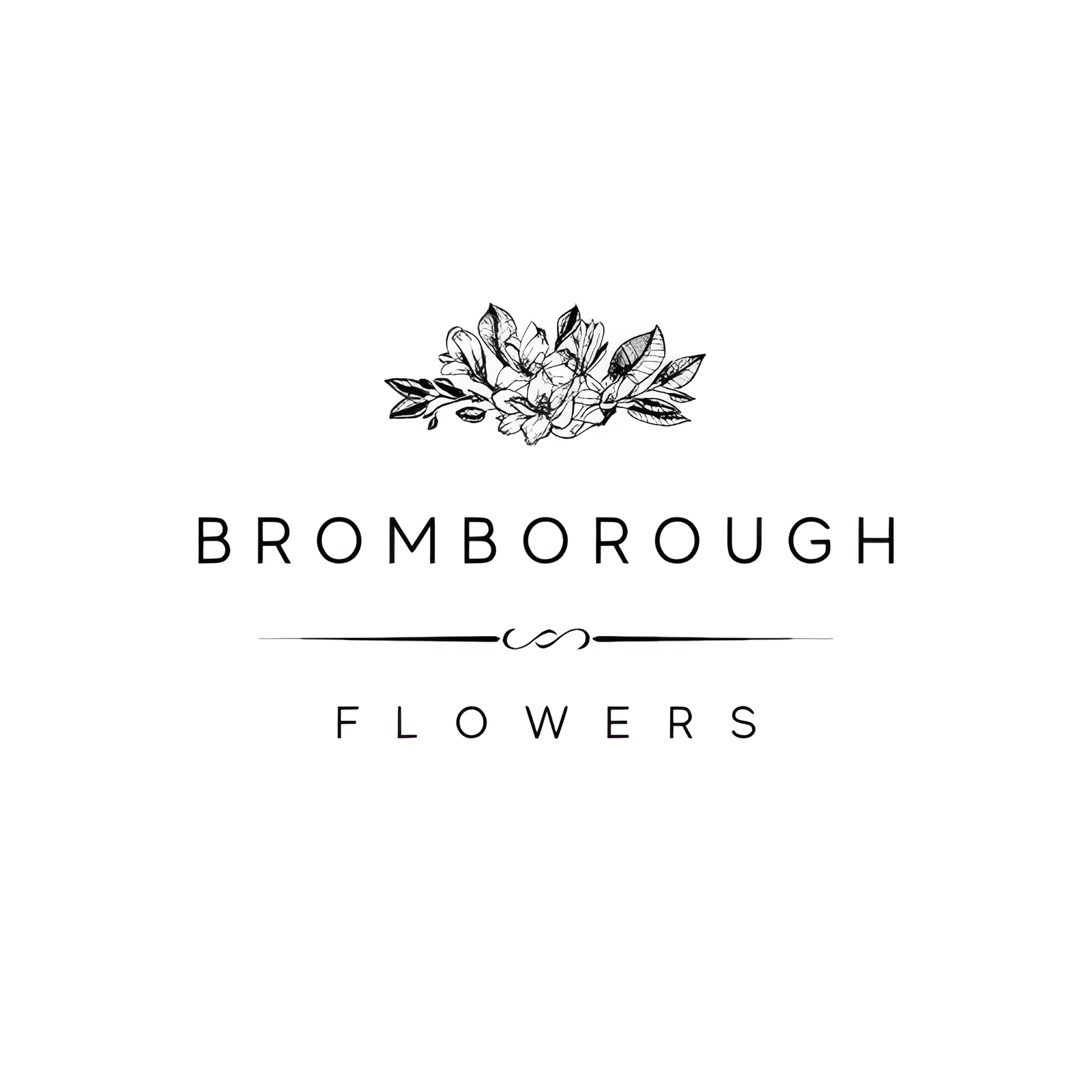In the world of wedding florals, the Cherry Blossom stands out as a symbol of fleeting beauty and profound love, offering an unmatched aesthetic for couples seeking an ethereal touch to their special day. This guide aims to explore the intricate details that make the Cherry Blossom an exceptional choice, from its physical attributes and color variations to its cultural significance and best growing conditions. By understanding these elements, couples can make more informed decisions about incorporating this elegant bloom into their wedding decor. But what truly sets the Cherry Blossom apart in wedding settings?
Flower Overview
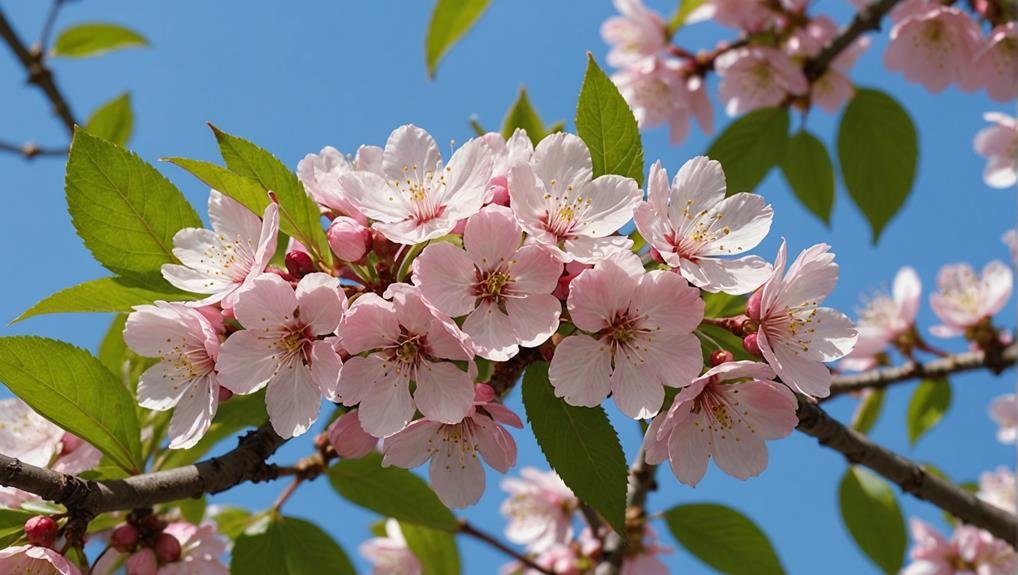
Cherry blossoms, renowned for their delicate beauty and symbolic significance, offer an exquisite touch to wedding decor. In various cultures, these flowers embody love, beauty, and the fleeting nature of life, making them a profound choice for couples looking to infuse their ceremonies with deeper meaning.
The bloom period of cherry blossoms is notably brief, which adds an element of exclusivity and uniqueness to any wedding setting. Their soft pink hue renders cherry blossoms both versatile and suitable for weddings of all styles and seasons. This gentle color harmonizes effortlessly with a range of palettes, whether the wedding theme is rustic, modern, or traditional.
The timeless appeal of cherry blossoms ensures they blend seamlessly with different wedding themes, enhancing the overall aesthetic. Incorporating cherry blossoms into wedding decor, such as bouquets, centerpieces, and decorative accents, helps cultivate a romantic and dreamy atmosphere. Their ephemeral nature not only adds a touch of elegance but also serves as a poignant reminder of the beauty and transience of life and love.
As a versatile floral option, cherry blossoms can adapt to various decor elements, providing a cohesive and enchanting experience for the special day.
Physical Description
Renowned for their ornamental beauty, cherry blossoms are delicate flowers featuring either pink or white hues, each with five petals and a central stigma. These blossoms are not only visually enchanting but also emit a subtle, sweet fragrance that enhances their appeal in floral arrangements. Typically, cherry blossoms grow in clusters, adorning the branches of cherry trees with a profusion of blooms during their peak season.
Cherry blossoms have a notably brief lifespan, generally lasting about two weeks. This fleeting period of bloom makes them a cherished sight, often symbolizing the transient nature of life. Each tree can produce hundreds to thousands of delicate blossoms, creating a mesmerizing spectacle that is both ephemeral and unforgettable.
To provide a more detailed understanding, here is a concise summary in tabular form:
| Attribute | Description | Details |
|---|---|---|
| Color | Pink or White | Adds visual allure to any setting |
| Petals | Five Petals | Simple yet elegant structure |
| Stigma | Central Stigma | Key reproductive part of the flower |
| Bloom Formation | Clusters | Multiple flowers grouped together |
| Lifespan | Short Lifespan | Approximately two weeks, highlighting their brief beauty |
This table succinctly captures the physical characteristics of cherry blossoms, emphasizing their delicate nature and ornamental appeal.
Available Colour Varieties
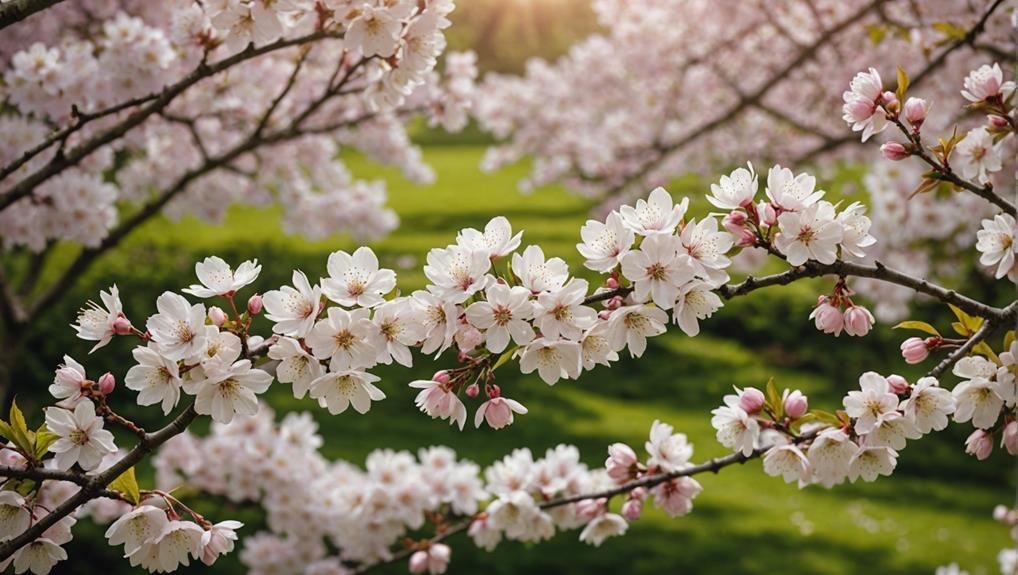
Among the various available color varieties of cherry blossoms, shades of pink, white, and dark pink offer a versatile palette for creating stunning and meaningful floral arrangements. These color variations allow couples to tailor their wedding decor to reflect different themes and emotions.
Cherry blossoms in pink hues are particularly popular in wedding floral arrangements due to their association with love, beauty, and romance. The soft and delicate pink petals create a dreamy and enchanting atmosphere, perfect for celebrating the union of two individuals.
White cherry blossoms, on the other hand, evoke a sense of purity, innocence, and new beginnings. Their pristine appearance adds an element of elegance and simplicity to wedding decor, making them an ideal choice for couples who favor a classic and timeless aesthetic.
For those seeking to add a touch of drama and sophistication, dark pink cherry blossoms are an excellent choice. Their rich and vibrant color can create a striking contrast within floral arrangements, adding depth and visual interest.
Latin Name and Taxonomy
Understanding the scientific classification of cherry blossoms, known by their Latin name Prunus serrulata, offers insight into their botanical lineage and the broader Rosaceae family to which they belong. The Rosaceae family is renowned for its diverse array of flowering plants, including roses, apples, and strawberries. Within this family, cherry blossoms are part of the Prunus genus, a group that encompasses various trees and shrubs distinguished by their ornamental beauty and fruit-bearing capabilities.
The taxonomy of Prunus serrulata places it within the subfamily Amygdaloideae, which includes other notable flowering plants. This subfamily is characterized by its members' distinctive petal structures and flower colors, traits that contribute significantly to their horticultural appeal. Cherry blossoms are further classified into different species and cultivars, each exhibiting unique variations in flower color and petal structure.
These variations make cherry blossoms a versatile choice for wedding decorations, allowing for a wide range of aesthetic possibilities.
Geographical Origins
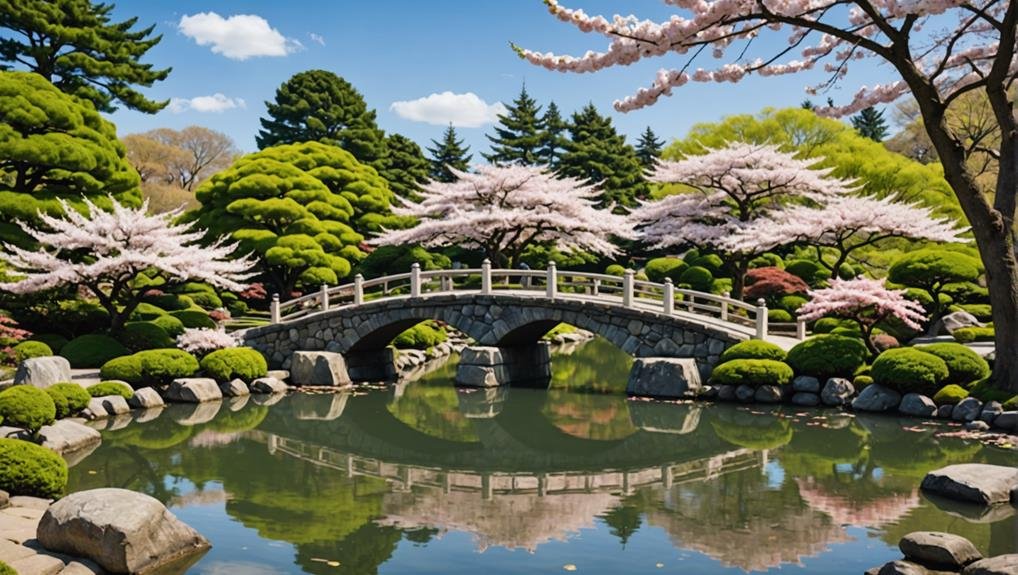
Cherry blossoms, originally native to East Asia, have deep cultural and historical significance in Japan, Korea, and China. These delicate flowers are not only admired for their beauty but also hold profound symbolic meanings, particularly in Japanese culture where they epitomize the ephemeral nature of life. In Japan, the 'Sakura season' is a time of national celebration, marked by numerous festivals and gatherings under the blooming cherry trees.
Japan:
Known for its iconic cherry blossom festivals, Japan celebrates 'Hanami,' where people gather to enjoy the flowers' fleeting beauty.
Korea:
Cherry blossoms are celebrated with festivals such as the Jinhae Gunhangje Festival, attracting millions of visitors annually.
China:
These blooms are associated with femininity and beauty, celebrated during various springtime events.
Worldwide Spread:
Due to their symbolic and aesthetic appeal, cherry blossoms have been planted in many parts of the world, including North America and Europe.
The cultivation and celebration of cherry blossoms have endured for centuries in East Asia, becoming a symbol of renewal and the transient nature of life. Their worldwide spread underscores their universal appeal, making them a favored choice for weddings and other significant occasions.
Season Availability
While cherry blossoms are renowned for their breathtaking beauty, their availability is limited to the short blooming period between March and April. During this time, cherry blossom branches reach their peak bloom, typically in April, offering a brief yet splendid display. This limited season of availability makes them a sought-after choice for spring weddings, where their delicate petals can add an ethereal touch to the decor.
However, the timing of cherry blossom blooms can be unpredictable and is often influenced by weather conditions. Factors such as temperature fluctuations and precipitation can either expedite or delay the blooming process. Hence, expertise is essential in managing these variables to make sure the blossoms are at their best for your event. Professionals in the floral industry often employ techniques to force blooms open or delay their peak opening to align with specific dates.
Proper care and conditioning are necessary to preserving the freshness and appearance of cherry blossom branches. This involves careful handling and appropriate storage conditions to prevent premature wilting. For weddings in early May, cherry blossom branches can be imported from Canada to extend their availability slightly, making sure that these stunning flowers can be enjoyed even outside their natural blooming period.
Growing Conditions
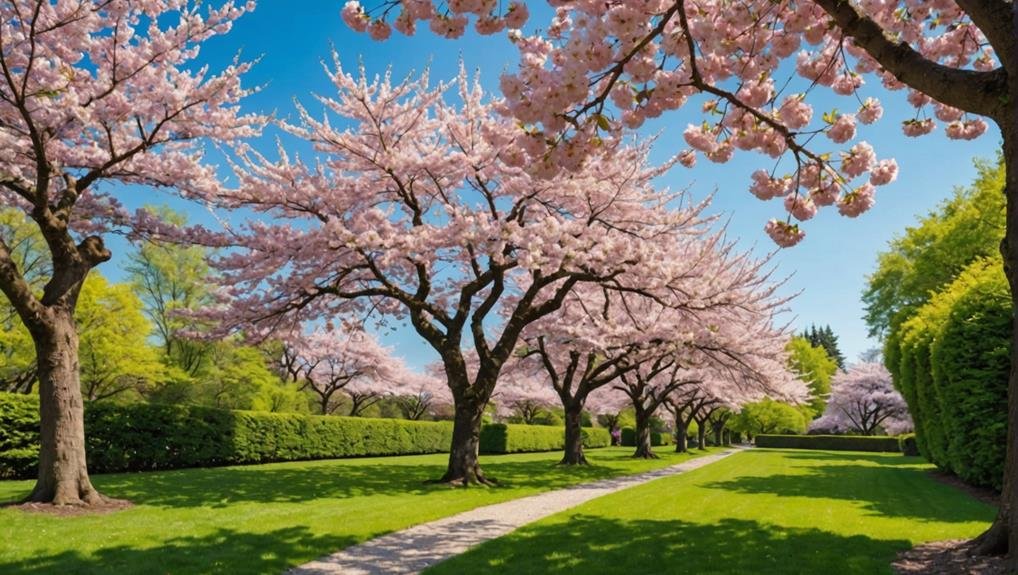
In temperate climates, cherry blossoms thrive when provided with ample sunlight and well-drained, fertile soil. These conditions are vital for promoting robust growth and a vibrant display during the blooming season.
Sufficient watering, especially during dry periods, is essential for maintaining the health of the trees. However, caution must be taken to avoid waterlogging, which can damage the roots.
Cherry blossom trees also benefit from regular pruning, which should ideally be done in late winter or early spring. This practice helps stimulate new growth and improves flowering potential. Pruning removes dead or diseased branches, allowing for better air circulation and light penetration within the canopy.
Protection from strong winds and frost is another crucial aspect of caring for cherry blossoms. These environmental factors can cause significant harm to the trees, impacting their overall health and blooming capability. Implementing measures to shield the trees can help reduce these risks.
Key considerations for optimal cherry blossom growth include:
- Ample sunlight exposure: Ensures adequate light for photosynthesis and growth.
- Well-drained soil: Prevents root rot and supports healthy root development.
- Pruning: Stimulates new growth and enhances flowering.
- Protection from wind and frost: Minimizes environmental stress and potential damage.
Cultural Significance
Celebrated for their exquisite beauty and symbolism, cherry blossoms hold profound cultural significance in various societies, particularly in Japan. As Japan's national flower, cherry blossoms, or 'sakura,' epitomize beauty, renewal, and the ephemeral nature of life.
This cultural importance is deeply rooted in the Japanese philosophy of mono no aware, which appreciates the fleeting beauty of impermanence.
Cherry blossoms bloom for a mere two weeks each spring, marking a period of new beginnings and renewal. This brief lifespan underscores their association with the ephemeral nature of existence, urging individuals to cherish the present moment.
The delicate pink hues and fragile petals of cherry blossoms are also emblematic of love and romance, qualities that have endeared them to many cultures around the world.
In Japan, cherry blossoms herald the arrival of spring and symbolize hope, renewal, and the start of a new chapter. Their brief yet vibrant bloom is a reminder of life's transient beauty, encouraging an appreciation for moments of fleeting perfection.
This cultural reverence for the cherry blossom's beauty and significance has made it a poignant and meaningful symbol in various traditions and celebrations globally.
Typical Use in Weddings
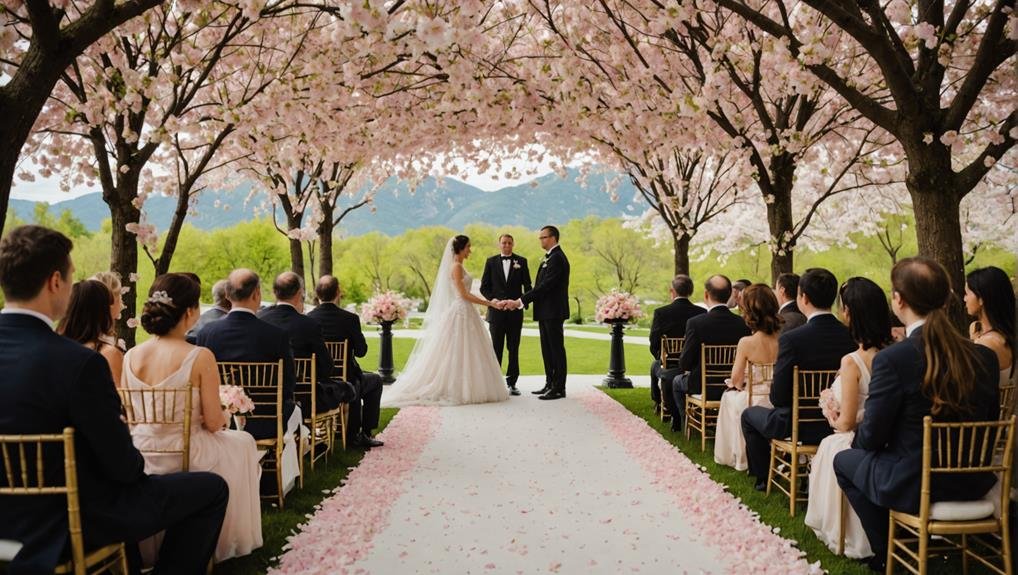
Cherry blossoms are a popular choice for wedding decor, frequently featured in bouquets, centerpieces, arch decorations, aisle accents, and cake adornments. Their delicate pink hue and ethereal beauty make them an ideal choice for creating a romantic and dreamy ambiance, particularly for spring weddings and outdoor ceremonies.
Cherry blossoms carry rich symbolism, representing love, beauty, renewal, and the fleeting nature of life. This symbolic significance adds a layer of sentimental value to any wedding decor, making the celebration even more meaningful. Additionally, their versatility allows them to blend seamlessly with various color palettes, enhancing the overall aesthetic of the event.
One of the key advantages of incorporating cherry blossoms into wedding decor is their sustainable and seasonal nature. By choosing cherry blossoms, couples can opt for a more eco-friendly and timely choice that aligns with the season, symbolizing new beginnings and fresh starts in marriage.
- Bouquets: Cherry blossoms can be the focal point or a delicate accent.
- Centerpieces: Enhance table decor with their subtle elegance.
- Arch Decorations: Perfect for framing the wedding ceremony space.
- Aisle Accents: Create a romantic path for the bride's entrance.
Alternative Flower Types
While cherry blossoms are undeniably enchanting, several alternative flower types can achieve a similar romantic and delicate aesthetic in wedding decor. Light pink stock flowers, for instance, offer a comparable soft hue and can be used effectively in various arrangements. Incorporating high-quality silk flowers is another excellent option to supplement fresh cherry blossoms, ensuring a lasting effect throughout the event.
Creating mixed arrangements allows for the enhancement of cherry blossoms with other complementary flowers, resulting in unique floral designs that stand out.
When considering vases, it is advisable to avoid clear glass vases, as the branches can sometimes make the water appear dirty. Instead, opting for opaque or decorative vases can maintain the overall elegance of the display.
Exploring creative solutions beyond actual cherry blossom branches can also lead to unique and memorable wedding decor. For example, flowering branches or other alternative flower types can emulate the ethereal beauty of cherry blossoms.
Additionally, for couples looking to mix and match, experimenting with various flowers and greenery can help achieve a harmonious and visually appealing setup. By exploring options and combining different elements, couples can create a stunning and personalized floral design that complements their special day.
